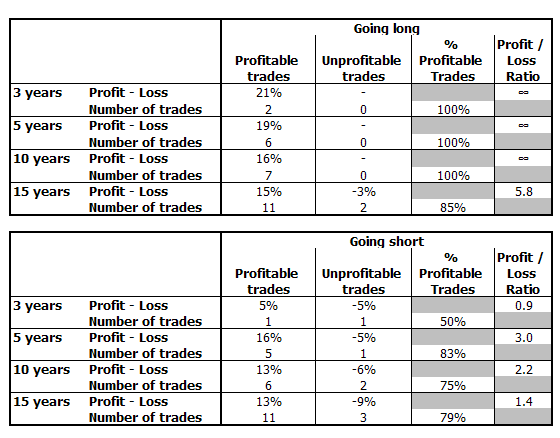Profitability and Success Probability of Trend Trades
Both long-term investors and traders like to know what the historical performance is of a trend indicator. Find out here what profit/loss ratio and what percentage of successful trades you can expect when you use a proven long-term trend signal.
Before going to the data, let’s answer first some fundamental questions. Why would we look at historical investment results at all? Everybody knows that history does not offer a guarantee for future performance. Still, I think it is wise to study the past. History does not always repeat itself, but often it does. And often is good enough for me.
Probability Game
To me, investing and trading is playing the probability game. There is no certainty. But you want to play the game in such a way that you have the highest probability for success. Using the past to see what has worked and what didn’t work can help you to get a plausible edge in the game.
The analysis below is based on trend following the S&P 500 with the MATI trend signal. This signal has only two statuses. It tells you if the trend is up or if it is down. When you follow this signal and it points up, you buy an S&P 500 index fund like the SPY (going long). The investing outcomes below are based on the case that such an index fund is used.
When the trend signal points down, you have a choice between selling your funds and going cash (or some other investment) or by selling the index with for example a Short Index Fund (going short).
Analysis Trading History
To provide insight in the historical trading performance of the trend signal, we look at the following results:
- We make a distinction between “going long” and “going short” situations.
- We consider periods of different lengths: the last 3, 5, 10 and 15 years.
- For each period, we see how many trades were made and what percentage of these trades was profitable.
- For each period, we calculate the profit/loss ratio: the average profit percentage divided by the average loss percentage for the trades made during that period.
Main Conclusions
Further below, you will find a table that summarizes the data for the different periods and situations. Here are the main conclusions for the last 10 years:
- 100% of the “going long” trades were profitable. There were 7 trades.
- The average gain per “going long” trade was 16%.
- 75% (6 out of 8) of the “going short” trades were profitable.
- The average gain per profitable trade was 13%. The average loss per unprofitable trade was 6%. Thus the profit loss ratio is 2.2.
See below the outcomes for each period length.
Profitable and Unprofitable Trades
See the table below for the percentage of profitable trades and the profit/loss ratio for the different periods for the “going long” and going short” situations.

A next time, I will show you what the largest draw-downs are for the different periods.
Questions and comments on the profitability and probability of these trend trades are welcome.
Next & Previous Blog Post
- ‹ previous
- 153 of 174
- next ›


